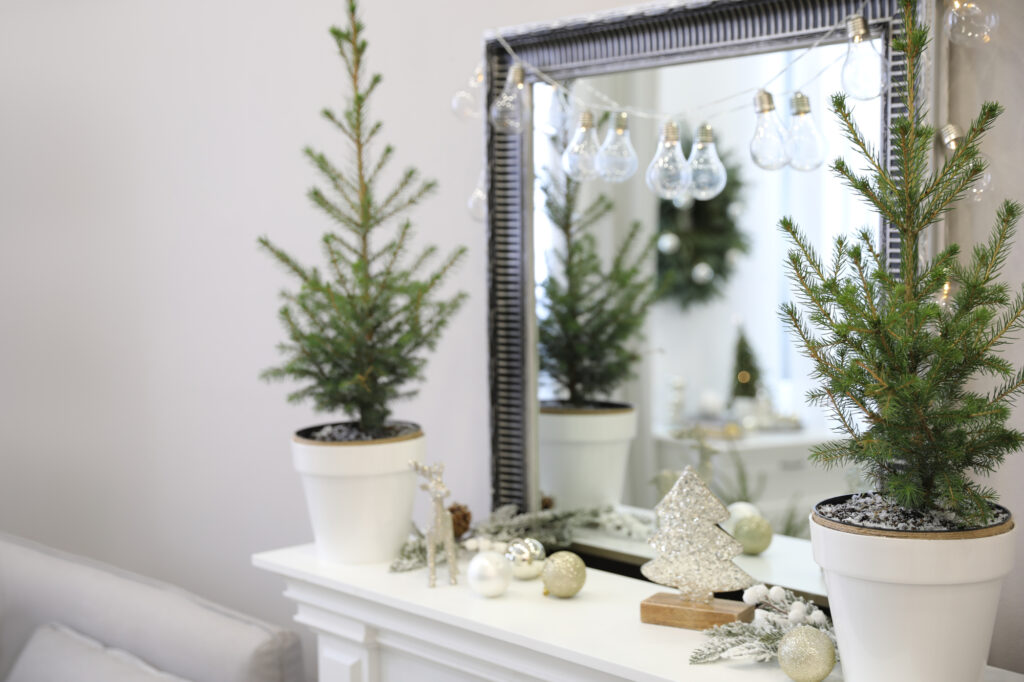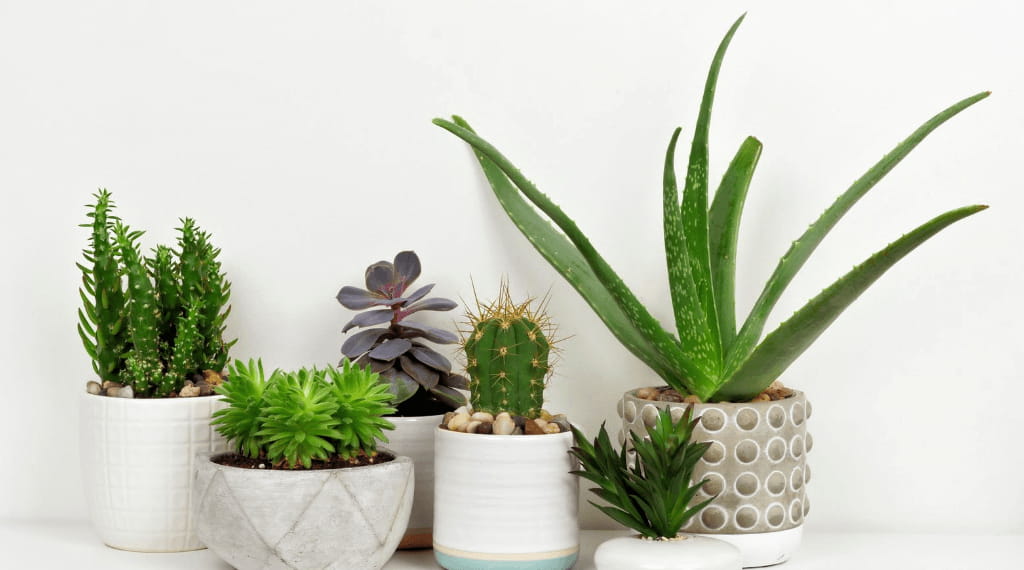Last Updated on June 22, 2024 by Plantiful Interiors
6 Amazing Indoor Plants for Decorating during the Christmas holidays
As the festive season approaches, it’s time to deck the halls with some beautiful houseplants that will bring some greenery and brighten up your home.
Adding greenery to your decor not only enhances the holiday spirit but also brings a sense of warmth and life to your space.
This post contains affiliate links. As an affiliate partner of various brands, we earn a little commission on qualifying purchases, at no extra cost to you. When you purchase through our links, you help our business to keep going. So thank you for your support! You may read our full disclaimer for more information.
If you’re looking for the perfect plants to decorate with during the Christmas season, here are 6 of my favorite houseplants that will surely add some holiday cheer to your home.
1. Poinsettia (Euphorbia pulcherrima)

Best known for its vibrant red, white, or pink bracts, the Poinsettia has become an iconic decoration during the holiday season.
When using poinsettias for holiday decor, it’s important to provide them with ideal light conditions to maintain their beauty.
They thrive in bright, indirect sunlight for at least six hours a day.
Direct sunlight can be too harsh, while low light can cause the plant to become leggy and lose its vibrant color.
Maintaining a comfortable indoor temperature, avoiding cold drafts, and ensuring proper watering will help keep poinsettias looking their best throughout the festive season.
Originally native to Mexico, this plant blooms in winter, making it a fitting symbol for Christmas festivities.
The Poinsettia is one of my favorite plants for decorating during Christmas.
2. Christmas Cactus (Schlumbergera)

The Christmas cactus, another popular choice for holiday decor and plants for decorating.
It is cherished for its unique, cascading blooms that typically appear in vibrant shades of red, pink, white, or yellow during the winter season.
Native to the tropical rainforests of Brazil, this plant differs from its desert-dwelling relatives by thriving in a more humid environment.
Ideal for indoor decoration, the Christmas cactus requires bright, indirect light to thrive, mimicking its natural habitat under the canopy of trees.
Direct sunlight can scorch its leaves, while insufficient light can hinder blooming.
For optimal growth, place the plant in a well-lit room where it can receive a few hours of indirect sunlight daily.
Additionally, maintaining moderate temperatures and regular watering, while allowing the soil to dry out slightly between waterings, will ensure the Christmas cactus remains healthy and vibrant throughout the holiday season.
3. Norfolk Island Pine (Araucaria heterophylla)

Resembling a miniature Christmas tree, the Norfolk Island Pine is a great alternative to the traditional Christmas trees, for those who prefer a more subtle holiday decoration.
With its symmetrical branches and soft, green needles, this plant brings a touch of natural elegance to indoor settings.
Originally from the South Pacific, the Norfolk Island Pine thrives indoors with the right care.
For optimal growth, it requires bright, indirect light, as direct sunlight can cause its needles to turn yellow and drop.
Ideally, place the plant near a window with filtered light, ensuring it gets at least several hours of indirect sunlight each day.
Consistent temperatures, avoiding drafts, and regular watering—allowing the top inch of soil to dry out between waterings—will help maintain its lush, vibrant appearance throughout the holiday season and beyond.
The Norfolk Island Pine, scientifically known as Araucaria heterophylla, is also commonly referred to by several other names.
These include the Australian Pine, Star Pine, and Living Christmas Tree.
Despite its common names, it is not a true pine but rather a member of the Araucariaceae family but a go-to choice when it comes to plants for decorating.
These alternative names reflect its popularity as a decorative plant and its distinctive, symmetrical appearance, which makes it a favored choice for festive indoor decoration.
4. Amaryllis

The Amaryllis, with its stunning, trumpet-shaped flowers, is a favorite for holiday decorating due to its dramatic blooms and ease of care.
Originating from South America, this plant typically produces vibrant red, white, pink, or striped flowers that can add a splash of color to any indoor setting during the winter months.
For optimal growth and blooming, the Amaryllis requires bright, indirect light.
Placing the plant near a sunny window where it can receive ample light without being exposed to direct sunlight is ideal, as too much direct light can scorch its leaves and hinder flower development.
Maintaining moderate indoor temperatures and providing consistent watering—keeping the soil moist but not waterlogged—will ensure the Amaryllis thrives and continues to bloom, making it a captivating centerpiece for holiday décor.
5. Holly (Ilex)

Holly, with its glossy green leaves and bright red berries, is a quintessential plant for holiday decorating, symbolizing cheer and festivity.
Traditionally associated with Christmas, holly is often used in wreaths, garlands, and centerpieces to add a touch of natural beauty to holiday décor.
This evergreen shrub thrives in outdoor settings but can also be used indoors with proper care.
When decorating with holly indoors, it is important to provide it with bright, indirect light to keep its foliage vibrant and healthy.
Direct sunlight can be too intense, potentially causing leaf scorch, while insufficient light can lead to a dull appearance.
Holly likes cooler indoor temperatures and should be kept away from heat sources such as radiators or fireplaces.
Keeping the soil consistently moist but well-drained will also help maintain its striking appearance throughout the holiday season.
Another favorite of mine when it comes to houseplants for decorating during the holidays (especially the artificial ones).
6. Red-berried Mistletoe (Viscum cruciatum)

Mistletoe, an iconic symbol of holiday romance and tradition, is widely used in festive decorating, often hung in doorways to inspire the custom of kissing beneath it.
It is not to be confused with the holly plant.
This evergreen plant, with its small, white berries and leathery leaves, has a long history of use in Christmas celebrations.
Mistletoe is typically harvested from trees in the wild and brought indoors for decoration.
While mistletoe doesn’t require light once it’s cut, if you’re displaying a living mistletoe plant, it should be placed in bright, indirect light to mimic its natural conditions in tree canopies.
Direct sunlight can be too harsh, potentially drying out the plant, while low light levels may not support its longevity.
To maintain its freshness, mistletoe should be kept in a cool, humid environment, away from heat sources and drafts.
Proper care ensures that this festive plant remains vibrant throughout the holiday season, adding a touch of tradition and charm to holiday décor.
Wrapping up 6 Amazing Plants for Decorating during the Holidays
These 6 houseplants are perfect for creating a festive ambiance in your home during the Christmas holidays.
Just remember to place them in the right amount of light and water them accordingly to keep them looking their best throughout the season.



